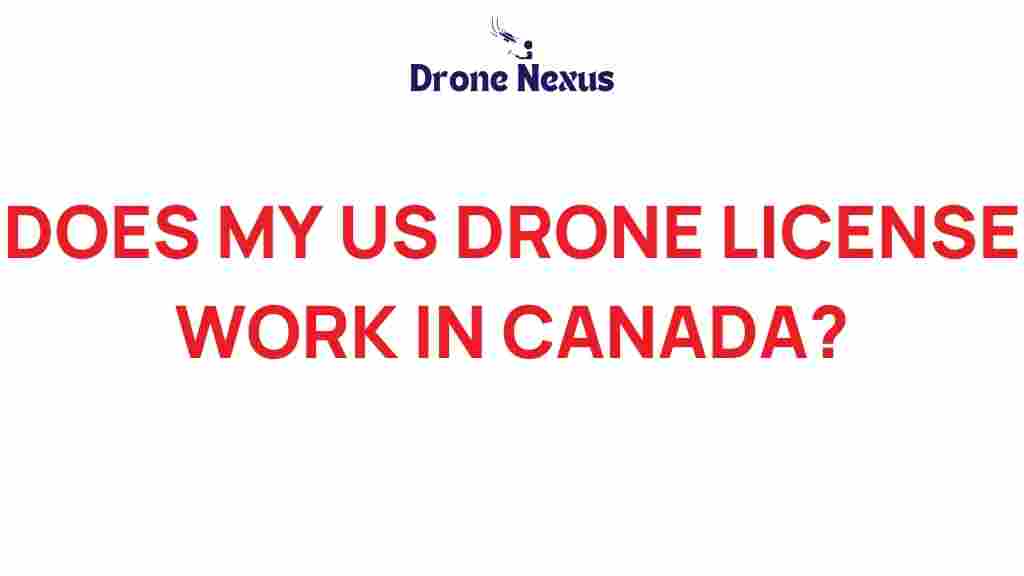Can You Use Your U.S. Drone License in Canada? Here’s What You Need to Know
As the popularity of drones continues to soar, many drone enthusiasts and professionals are looking to expand their horizons. One common question that arises is whether a U.S. drone license is valid in Canada. This article aims to clarify this question and provide essential information for drone operators planning to fly across the border.
Understanding the U.S. Drone License
Before diving into the regulations of flying a drone in Canada with a U.S. drone license, it’s essential to understand what a U.S. drone license entails. In the United States, the Federal Aviation Administration (FAA) regulates drone operations, and drone pilots must obtain a license under Part 107 if they intend to fly for commercial purposes.
- Part 107 License: This license is required for commercial drone operations and includes passing a written test, being at least 16 years old, and undergoing a background check.
- Recreational Use: For recreational flying, while a license is not required, the operator must follow specific guidelines set by the FAA.
Having a U.S. drone license demonstrates a level of knowledge and skill in operating drones safely and responsibly, but does it hold any weight when flying in Canada?
Regulations in Canada
Canada has its own set of regulations for drone operation, governed by Transport Canada. The Canadian regulations are distinct and differ significantly from U.S. rules. Here’s what you need to know:
- Licensing: In Canada, drone operators must obtain a Special Flight Operations Certificate (SFOC) for commercial operations or pass an online exam to operate a basic or advanced drone.
- Weight Classifications: Drones are categorized by weight, with different rules applying to drones weighing under 250 grams and those above.
- Airspace Restrictions: Canadian regulations include strict guidelines on where drones can be flown, especially near airports, populated areas, and sensitive locations.
While the U.S. drone license signifies compliance with FAA regulations, it does not automatically grant permission to operate a drone in Canada. Thus, understanding the local regulations is crucial for U.S. drone pilots planning to fly in Canada.
Can You Use Your U.S. Drone License in Canada?
In short, the answer is no—you cannot use your U.S. drone license in Canada. Here’s why:
- Different Regulatory Framework: Canada and the U.S. have different regulatory bodies (Transport Canada vs. FAA) and different requirements for drone operation.
- Recognition of Licenses: Transport Canada does not recognize foreign drone licenses, including U.S. drone licenses, for operations within its airspace.
- Legal Implications: Operating a drone in Canada without the appropriate Canadian certification may lead to fines, confiscation of equipment, or other legal repercussions.
Steps to Fly a Drone in Canada with a U.S. Drone License
So, what should a U.S. drone pilot do if they want to operate a drone in Canada? Here’s a step-by-step guide:
Step 1: Research Canadian Regulations
Before planning your drone flight in Canada, familiarize yourself with the relevant regulations. Key areas to focus on include:
- Weight restrictions and classification of your drone.
- Geographical no-fly zones (e.g., near airports, schools, and national parks).
- Required licenses or certifications for your type of operation.
Step 2: Obtain the Necessary Certification
If you are planning to fly commercially, you will need to apply for a SFOC. For recreational flying, you must pass the online exam to obtain a Canadian drone pilot certificate. Here’s how:
- Visit the Transport Canada website and create an account.
- Study the materials provided for the online exam.
- Take and pass the exam to receive your drone pilot certificate.
Step 3: Prepare for Your Flight
Once you have obtained the necessary certification, you can prepare for your flight:
- Plan your flight path and ensure it complies with local regulations.
- Check the local weather conditions to ensure safe flying.
- Conduct a pre-flight inspection of your drone to ensure it is in good working condition.
Step 4: Fly Responsibly
When operating your drone in Canada, always prioritize safety and compliance with regulations:
- Maintain visual line-of-sight with your drone.
- Do not exceed the maximum altitude of 400 feet above ground level.
- Respect the privacy of individuals and avoid flying over crowds.
Troubleshooting Tips for U.S. Drone Pilots in Canada
While flying a drone in Canada can be an enjoyable experience, you may encounter challenges. Here are some troubleshooting tips:
Issue 1: Confusion over Regulations
Many U.S. drone pilots are unaware of the specific Canadian regulations. To avoid confusion:
- Always check the Transport Canada website for the latest regulations and updates.
- Join local drone pilot groups or forums to gain insights from experienced operators.
Issue 2: Language Barriers
If you are not fluent in French or English, you might face language barriers. In such cases:
- Use translation apps or devices to communicate effectively.
- Consider hiring a local guide who understands drone regulations and can assist you.
Issue 3: Technical Difficulties
Technical issues with your drone can occur at any time. To troubleshoot:
- Perform regular maintenance and updates on your drone’s software.
- Always carry spare parts like batteries and propellers.
Conclusion
In conclusion, while a U.S. drone license is a testament to your skills and knowledge as a drone operator, it does not grant you the right to fly in Canada. You must familiarize yourself with Canadian regulations and obtain the appropriate certifications to operate legally and safely. By following the steps outlined in this article, U.S. drone pilots can enjoy the vast and beautiful landscapes of Canada without running afoul of the law.
For more information on flying drones in Canada, visit the Transport Canada website. Additionally, if you want to explore more about drone regulations worldwide, check out this comprehensive guide.
This article is in the category Safety and created by DroneNexus Team
